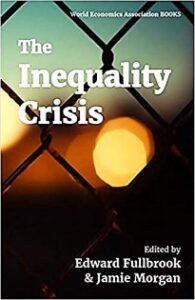Great and rising inequality
Jamie Morgan
An interest in great inequality and rising inequality have become prominent features of our times. According to Oxfam in 2019 the 26 richest people on the planet had equivalent wealth to the 3.8 billion who comprise the lower 50% of the world population. The previous year it required the top 43 to create this equivalence.
The 2020 Oxfam report adds a series of statistical claims: the world’s richest 1% have more than twice the wealth of 6.9 billion of the world’s population, the 22 richest men have more wealth than all the women in Africa (and the estimated value of the unpaid work of women in the world is $10.8 trillion).
A report from the Institute for Policy Studies, meanwhile, highlights that US billionaire’s tax obligations as a percentage of wealth reduced by 79% between 1980 and 2018 (Collins et al., 2020).
According to the UK High Pay Centre, the median pay of CEOs in the UK FTSE 100 was £3.9 million in 2017 (11% higher than 2016) and it would take a worker on median pay 125 years to earn this (and the equivalent figures for the Dow in the US are far greater).
According to the Equality Trust, FTSE 100 CEO “compensation” as a ratio to their own employees’ pay averaged 145:1 in 2017 (rising from 30:1 in 1970 and 50:1 in 1990).

Source: Real World Econ Rev blogs, 23 May 22
https://rwer.wordpress.com/23/great-and-rising-inequality/





























